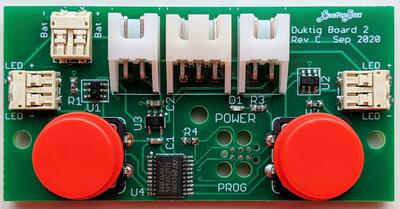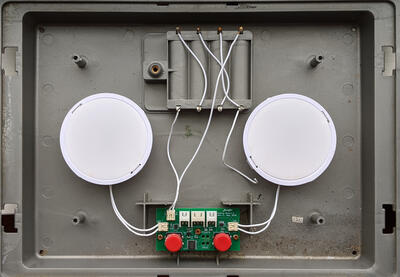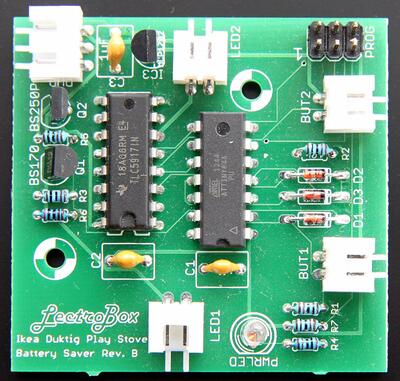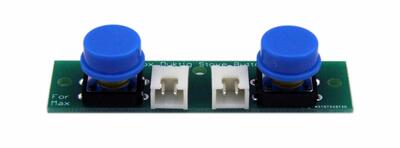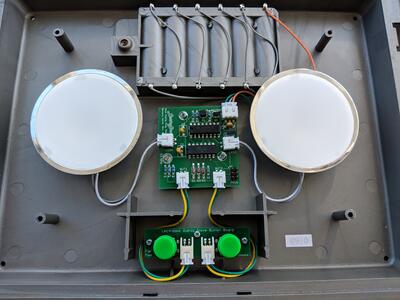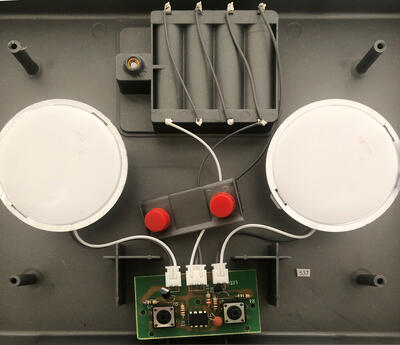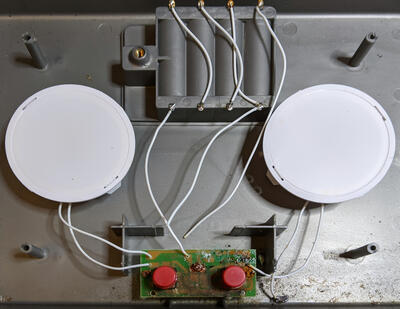Ikea Duktig Play Stove Battery Saver and Replacement Buttons
What is it?
Ikea makes a popular play kitchen for children called the Ikea Duktig Mini-kitchen. One of the features is a “stove” with two buttons that turn on red lights to make it look like the stove is getting hot. I designed replacements for the circuit boards inside it. My boards may help you get a broken stove working again. Even if your stove works, my versions are much more efficient than Ikea’s and can improve the battery life of the toy to years instead of weeks.
This project started in 2013 as a way to save batteries. The oldest Ikea Duktig stoves would drain their batteries in a matter of weeks, even if the stove was not used at all! I built a circuit board that was better than Ikea’s original and used virtually no power when off. It also turns the stove lights off automatically after two minutes to save even more battery power. I was so happy with the result that I started selling it.
A few years later, I realized that people were buying my circuit board not just to save batteries, but to get old, broken stoves working again. In many cases, the problem is actually with the buttons: one too many orange juice spills can corrode the buttons enough that they no longer work. So, in 2018, I started selling a second circuit board with buttons that are mechanically compatible with the original.
A couple of years after I started selling the original boards, Ikea changed the internal design of their stove in a way that made it incompatible with my original design. After many requests to update my design, I finally relented in 2020 and created a newly designed circuit board to work with more recent model Duktig stoves.
Purchase and Installation Instructions
Check your stove's battery compartment to see how many batteries it takes: 4, or 6? Ikea made 6-battery stoves until about 2014, and 4-battery stoves since then.
6-battery stoves (built 2014 and before)
The oldest Ikea Duktig stoves have 6 batteries. As seen in the photo on the right, 6-battery stoves have two circuit boards inside them. One has the electronics, the other just has the two buttons.
I sell both circuit boards on both Amazon and eBay. Amazon ships to the USA, Canada, and some European countries. If you have Amazon Prime, two-day shipping is free! eBay ships to dozens of countries via their Global Shipping Program, but shipping can be expensive to some countries.
4-battery stoves with connectors (2014-2016)
Ikea Duktig stoves built after 2014 have only 4 batteries. These newer models have only a single circuit board for both the electronics and the buttons.
There are two variants of the four-battery stove. From approximately 2014 to 2016, the circuit boards have connectors at the end of the wires used to attach them to the circuit board, as seen to the right. Those built after 2016 do not.
4-battery stoves without connectors (2017-present)
Starting around 2017, Ikea stopped using connectors and began producing Duktig circuit boards where the wires are permanently attached (soldered) to the circuit board. They probably did this to save a little money. Unfortunately, it makes replacement more difficult. I added special connectors to my replacement circuit board so that can bare wires can be directly attached to it.
Why did you build it?
My good friend Ben wrote to me one day. He had a problem: his kids love the Ikea Duktig Mini-kitchen. But its light-up play stove takes 6 batteries which seemed to drain every week or two. He’d tried using rechargeable batteries, but that just made the situation worse: they’d barely last a day. Ben knew I liked to tinker with electronics so asked me: could I fix it?
He mailed me the stove out of the Ikea kitchen. I started to tinker with the circuit board inside that controls the burners, and found it had two problems. First, and worst, the board was always drawing at least 3mA (three thousandths of an amp), even when the toy is off. This may not sound like a lot, but with typical 2700mAH AA batteries, the battery energy would be completely drained in less than 40 days.
Second, the LEDs were unregulated – there was a simple current clamping resistor between the 9v supply and the LEDs, a configuration that only works correctly when the supply voltage is quite close to 9v. This is only true with fresh alkaline batteries. The situation is even more precarious with rechargeable AAs, which are only about 1.25v each when fresh (versus 1.5v for alkaline). I measured the forward diode drop of the LEDs at about 5.8v, and the LEDs need around 15mA to be visible. Ikea’s clamping resistor was 110 ohms, so the supply voltage needs to be at least 7.45 volts for the LEDs to work.
Now, Ben’s problem had become clear. His stove was starting at 7.5v with his rechargeable batteries (1.25v per battery in series times 6 batteries), and the board’s cheap design meant that as soon as the batteries sagged by just five-hundredths of a volt, it would stop working. Because the board was drawing 3mA even when it was off guaranteed the lights would fail almost immediately with rechargeable batteries. Even alkaline batteries would be dead within a few weeks.
I created a new circuit board that fixes all these problems. First, it uses an LED driver as a constant-current source rather than a clamping resistor; this means the board will work over a wide range of battery voltages, even when the batteries start to run down. Second, I carefully designed the board to have very small idle power – a few microamps. In other words, my board’s idle power consumption is about one one-thousandth of Ikea’s original board. There’s a small microcontroller on my board that shuts itself completely off when the toy is not in use. The only significant idle power draw comes from the voltage regulator’s leakage; without that, I measured the idle power draw at 40 nano-amps!
At first, the new circuit board was not intended to be a product—I was just helping my friend fix his toy. But he was so thrilled with the improvement that he subsidized production of a larger batch of circuit boards so that we could share them with more people.
